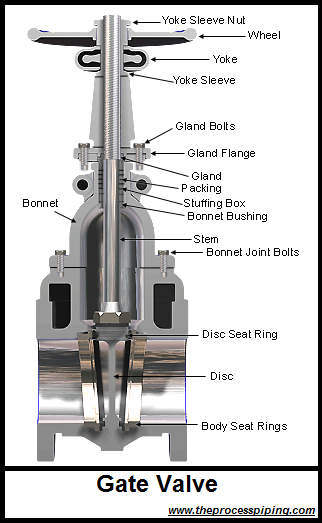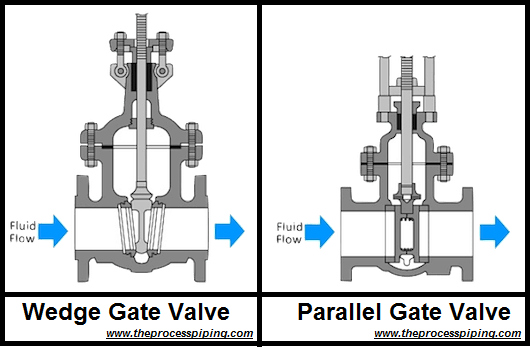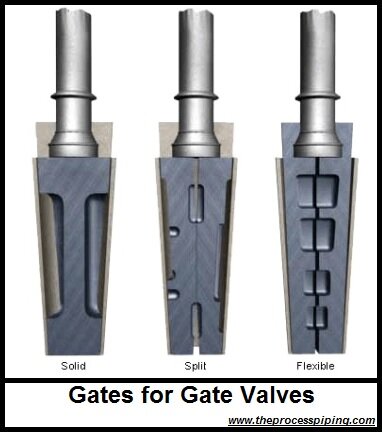Introduction to Gate Valve

Gate valves are used to shut off the flow of fluid by inserting a rectangular gate or wedge into the path of a flowing fluid. Gate valves require very little space along the pipe axis and hardly restrict the flow of fluid when the gate is fully opened enabling gate valves to offer straightway flow with very little pressure drop. Gate valves are mostly used with larger pipe diameters (from 2″ to the largest pipelines) since they are less complex to construct than other types of valves in large sizes. More recently, however, the larger sizes have been supplemented by butterfly valves due to space limitations under which they are installed.
The gate valve, as illustrated in on the right, generally consists of a gate-like disc, actuated by a screwed stem and hand-wheel which moves up and down at right angles to the flow. In the closed position, the disc seats against two faces to shut off flow. To retain the fluid in the pipeline, a gland is provided which is supplied with some type of packing to resist leakage.
Gate Valve Working Principle
Gate valves consist of three major components: body, bonnet, and trim. The body is generally connected to the piping by means of flanged, screwed, or welded connections. The bonnet, containing the moving parts, is joined to the body, generally with bolts, to permit cleaning and maintenance. The valve trim consists of the stem, the gate, the wedge, or disc, and the seat rings.

The main operation mechanism is very simple. When the hand-wheel is turned, it rotates the stem, which is translated into the vertical movement of a gate via threads. They are considered multi-turn valves as it takes more than one 360° turn to fully open/close the valve. When the gate is lifted from the path of the flow, the valve opens and when it returns to its closed position, it seals the bore resulting in a full closure of the valve.
Gate Valve Closing Member Design
The closing member, sometimes referred as gate also, comes in a variety of designs and technologies to produce effective sealing for differing applications. There are usually two types of gate valve closing members which are having further varieties.
-
Parallel Gate Valve – Use a flat gate between two parallel seats.
- Conventional Parallel Gate
- Through-Conduit Gate
- Knife Gate
-
Wedge Gate Valve – Use slightly mismatched inclined gate between inclined seats.
- Solid Taper Wedge
- Split Wedge
- Flexible Wedge

Parallel Gate Valve
Parallel gate valves have a parallel faced gate like closing member. This closing member may consists of a single disc or twin discs with a spreading mechanism in between. The force that presses the disc against the seat is controlled by the fluid pressure acting on either a floating disc or a floating seat. Because the disc slides across the seat face, parallel gate valves are also capable of handling fluids, which carry solids in suspension.
Conventional Parallel Gate Valve
In a conventional parallel slide gate valve the closure member consists of two discs with springs in between. The duties of these springs are to keep the upstream and downstream seating’s in sliding contact and to improve the seating load at low fluid pressures. The discs are carried in a belt eye in a manner that prevents their unrestrained spreading as they move into the fully open valve position.
The advantages offered by this construction include not only economy of construction but also a reduced operating effort and lower maintenance cost. The only disadvantage is a slight increase in pressure loss across the valve.
Through-Conduit Gate Valve

Through-conduit gate valves are one-unit gates that include a bore size hole as shown in figure on the right. In open state, the bore size hole is aligned with the two seat rings to create a smooth flow with minimal turbulence. This special design allows for minimal pressure loss on the system and is perfect for transportation of crude oil and natural gas liquids (NGLs). The valve seats remain clean, however, the disc cavity can capture foreign material. Therefore, the cavity typically has a built-in plug for maintenance purposes of draining the accumulated foreign material.
These valves are used in pipelines where pigs are run through the piping to perform cleaning of built-up deposits or debris. The typical applications of conduit valves include dirty river water with suspended solids or water with sludge or debris.
Knife Gate Valve

Knife Gate Valves are a specific type of parallel gate valve and is designed to handle systems with high content of suspended solids. The knife gate valves are especially beneficial for handling slurry, viscous, corrosive and abrasive media. The valve owes its ability to handle these fluids to the knife-edged disc, which is capable of cutting through fibrous material, and the virtual absence of a valve body cavity. The disc travels in lateral guides and is forced against the seat by lugs at the bottom. If a high degree of fluid tightness is required, the valve may also be provided with an O-ring seat seal.
The valves find application in paper and pulp, minerals and metals, steel plants, thermal power plants and chemical/ petrochemical industries. Knife gate valve has a short face-to-face length compared to other gate valves. As a consequence a knife gate valve is light weighted compared to other gate valves.
Wedge Gate Valve
Wedge gate valves differ from parallel gate valves in that the closure member is wedge-shaped instead of parallel. The purpose of the wedge shape is to introduce a high supplementary seating load that enables wedge gate valves to seal not only against high, but also low, fluid pressures. The degree of seat tightness that can be achieved with wedge gate valves is therefore potentially higher than with conventional parallel gate valves.
Efforts to improve the performance of wedge gate valves led to the development of a variety of wedge designs; the most common ones are described in the following section.
Solid or Plain Wedge Gate Valve
Solid or plain wedge is most common & widely used disk types because of its simplicity and strength. It can be of solid or hollow construction. This design has the advantage of being simple and robust, but distortions of the valve body due to thermal and pipeline stresses may unseat or jam the metal seated wedge making it more susceptible to leakage. A valve with solid wedge may be installed in any position, and it is suitable for almost all fluids. It can be used in turbulent flow also. Solid wedge is subjected to thermal locking if used in high-temperature service.
Thermal locking is a phenomenon in which wedge is stuck between the seats due to the expansion of the metal. Solid-wedge gate valves are generally used in moderate to lower pressure-temperature applications.
Efforts to overcome the alignment problem of plain wedges led to the development of self-aligning or split wedges. This permits the wedged gate to adapt itself to small amounts of distortion caused by pipeline strain or seat wear.
Split Wedge Gate Valve
Split wedge disk consists of two solid pieces and holds together with the help of special mechanism like a spacer ring or spring. To keep the plates together, the body has grooves in which the wedge assembly travels.Split wedge is self-adjusting and self aligning to both seats sides. Disk flexibility is inherent to the split wedge design. This flexibility allows the split wedge to seal more easily and it reduces stickiness between the sealing surfaces in cases where the valve seats are angularly misaligned. The mismatched angle is also designed with some free movement to allow the seating surfaces to match with each other.
This type of wedge is suitable for the treatment of non-condensing gases and liquids at normal temperatures, particularly corrosive liquids.
Flexible Wedge Gate Valve
The flexible wedge is a one-piece solid disk with a cut around the perimeter or with an integral boss in between. The wedge is sufficiently flexible to find its own orientation. Because the wedge is simple and contains no separate components that could rattle loose in service, this construction has become a favored design. This design improves seat alignment and offers better leak tightness. It also improved performance in situations where thermal binding possible.
The cut or integral boss will vary in size, shape and depth. A shallow, narrow cut gives little flexibility but retains strength. A deeper and wider cut, or cast-in recess, leaves little material in the middle, which allows more flexibility, but compromises strength.
The disadvantage of split gates is that process fluid tends to collect in between the disks. These may result in corrosion and ultimately weaken the disk.

Gate Valve Stem Design
The stem, which connects the hand-wheel and disk with each other, is responsible for the proper positioning of the disk. Stems are usually forged, and connected to the disk by threaded or other techniques. Depending on which end of the stem is threaded, stems can be rising or non-rising.
Rising Stem Gate Valve
Rising stems are fixed to the gate and they rise and lower together as the valve is operated, providing a visual indication of the valve position and making it possible to grease the stem. A nut rotates around the threaded stem and moves it. This type of valve has an inside screwed stem and the packing is subjected to wear because of the up and down movement and turning motion of the stem. This type is only suitable for above-ground installation.
Non Rising Stem Gate Valve
Non-rising stems are threaded into the gate, and rotate with the wedge rising and lowering inside the valve. Rotation of the wheel operates the valve, but the stem does not come out of the housing. They take up less vertical space since the stem is kept within the valve body. Non-rising valves are almost always fitted with a local visual pointer which indicates the position of the valve. Gate valves with non-rising stems are suitable for both above-ground and underground installations.

Metal Seated & Resilient Seated Gate Valves
A metal seated gate valve has a depression in the valve bottom. The conical wedge fits into the depression in the valve bottom to ensure a tight closure. Herewith, sand and pebbles are embedded in the bore. The pipe system will never be completely free from impurities regardless of how thoroughly the pipe is flushed upon installation or repair. Thus any metal wedge will eventually lose its ability to be drop-tight.
A resilient seated gate valve has a plain valve bottom allowing free passage for sand and pebbles in the valve. If impurities pass as the valve closes, the rubber surface will close around the impurities while the valve is closed. A high-quality rubber compound absorbs the impurities as the valve closes, and the impurities will be flushed away when the valve is opened again. The rubber surface will regain its original shape securing a drop-tight sealing.

Use of Gate Valves
Gate valves meet the majority of valve requirements in process piping and are considered one of the most used valves of all the valves employed in refineries, petrochemical, and gas processing plants where pressure remains relatively low, but temperature may be very high. They are suitable for most fluids including steam, water, oil, air, and gas.
Gate valves are designed for fully open or fully closed service. They are installed in pipelines as isolating valves, and should not be used as flow control or regulating valves. When operating the valve stem, the gate moves up- or downwards on the threaded part of the stem.
Gate valves are often used when minimum pressure loss and a free bore is needed. When fully open, a typical gate valve has no obstruction in the flow path resulting in a very low pressure loss, and this design makes it possible to use a pipe-cleaning pig. A gate valve is a multiturn valve meaning that the operation of the valve is done by means of a threaded stem. As the valve has to turn multiple times to go from open to closed position, the slow operation also prevents water hammer effects.
Gate valves should not be used for regulation or throttling of flow because,
- The flow rate of the fluid is not proportional to the amount that the valve is open thus accurate control of fluid flow is not possible. T
- Shearing of high-velocity flow will cause a partially open gate valve from vibration which will damage the seating surfaces and prevent a tight seal.
- Gate and seat may be subject to excessive wear if the valve is partially open.
Gate Valve with by-pass
At high pressures, friction can become a problem. The seating load of the larger gate valves (except those with floating seats) can become so high at high fluid pressures that friction between the seating’s can make it difficult to raise the disc from the closed position. Such large gate valves are therefore frequently provided with a valved bypass line, which is used to relieve the seating load prior to opening the valve.
By-pass valves are generally used for three basic reasons:
- To allow the pipeline differential pressure to be balanced, lowering the torque requirement of the valve and permit one-man operation.
- With the main valve closed and the by-pass open, a continual flow is allowed, avoiding possible stagnation.
- Delayed filling of pipelines.
Pressure-Equalizing Connection
Sometimes during the operation of gate valves, thermal expansion of a liquid trapped in the closed valve chamber will force the upstream and downstream discs into more intimate contact with their seats, and cause the pressure in the valve chamber to rise. The higher seating stress makes it in turn more difficult to raise the discs, and the pressure in the valve chamber may quickly become high enough to cause a bonnet flange joint to leak or the valve body to deform. Thus, if gate valves are used to handle a liquid with high thermal expansion, they must have a pressure-equalizing connection that connects the valve chamber with the upstream piping. The pressure-equalizing connection may be provided by a hole in the upstream disc or by other internal or external means.
Advantages and Dis Advantages
Advantages of Gate Valve
- Gate valve provides good on/off or shutoff features.
- Pressure drop during operation is very less.
- Gate valves are bi-directional valves and can provide shut-off in either flow directions.
- They are suitable for high pressure and temperature application and required less maintenance.
- Gate valves tend to be slightly cheaper than ball valves of the same size and quality.
Disadvantage of Gate Valve
- It cannot be used to regulate or throttle the flow.
- A gate valve is slow in operation and can not be quickly opened or closed. This is good also as it reduces the chance of hammering.
- It is prone to vibration and noise in the partially open state.
- It is more subject to seat and disk wear.
- Gate valves require large space envelope for installation, operation, and maintenance.
- Repairs, such as lapping and grinding, are generally more difficult to accomplish.
- Some designs of gate valves are susceptible to thermal or pressure locking, depending upon the application.
a technical knowledge base for all the process piping professionals around the world…